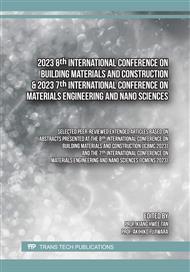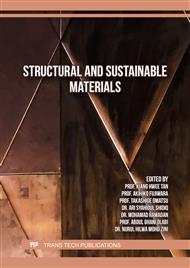[1]
"Climate change: The massive CO2 emitter you may not know about - BBC News." https://www.bbc.com/news/science-environment-46455844 (accessed Jul. 19, 2022).
Google Scholar
[2]
"The Environmental Impacts of Concrete." https://www.greenspec.co.uk/building-design/environmental-impacts-of-concrete/ (accessed Jul. 19, 2022).
Google Scholar
[3]
"Cement – Analysis - IEA." https://www.iea.org/reports/cement (accessed Jul. 19, 2022).
Google Scholar
[4]
"Cement Producers Are Developing a Plan to Reduce CO2 Emissions - Scientific American." https://www.scientificamerican.com/article/cement-producers-are-developing-a-plan-to-reduce-co2-emissions/ (accessed Jul. 19, 2022).
Google Scholar
[5]
S. K. B. B. Singh, G. Ishwarya, M. Gupta, "Geopolymer concrete: A review of some recent developments," Construction and Building Materials, vol. 85, p.78–90, 2015.
DOI: 10.1016/j.conbuildmat.2015.03.036
Google Scholar
[6]
J. Davidovits, "Geopolymers - Inorganic polymeric new materials," Journal of Thermal Analysis, vol. 37, no. 8, p.1633–1656, 1991.
DOI: 10.1007/BF01912193
Google Scholar
[7]
P. C. A. Wongsa, Y. Zaetang, V. Sata, "Properties of lightweight fly ash geopolymer concrete containing bottom ash as aggregates FA," CONSTRUCTION & BUILDING MATERIALS, vol. 111, p.637–643, 2016.
DOI: 10.1016/j.conbuildmat.2016.02.135
Google Scholar
[8]
T. W. Samadhi, W. Wulandari, M. I. Prasetyo, and M. R. Fernando, "Reuse of Coconut Shell, Rice Husk, and Coal Ash Blends in Geopolymer Synthesis," IOP Conference Series: Materials Science and Engineering, vol. 248, no. 1, 2017.
DOI: 10.1088/1757-899X/248/1/012008
Google Scholar
[9]
A. Wastes, "Short Communication Pyrolysis of Coconut Shell and its Potential as Fuel," vol. 17, p.313–317, 1986.
Google Scholar
[10]
D. Hardjito and B. v Rangan, "Development and Properties of Low-calcium Fly Ash Based Geopolymer LOW-CALCIUM FLY ASH-BASED GEOPOLYMER CONCRETE By Faculty of Engineering Curtin University of Technology," Australia : University of Technology Perth, no. January, p.48, 2005.
DOI: 10.1201/9781420007657.ch26
Google Scholar
[11]
B. V. R. Djwantoro Hardjito, Steenie E. Wallah, Dody M. J. Sumajouw, "On the Development of Fly Ash-Based Geopolymer Concrete," Materials Journal, vol. 101, no. 6, p.467–472, 2004.
Google Scholar
[12]
A. V. Girão, G. Caputo, and M. C. Ferro, "Application of Scanning Electron Microscopy–Energy Dispersive X-Ray Spectroscopy (SEM-EDS)," Comprehensive Analytical Chemistry, vol. 75, no. November, p.153–168, 2017.
DOI: 10.1016/bs.coac.2016.10.002
Google Scholar
[13]
J. L. White, "Interpretation of infrared spectra of soil minerals," Soil Science, vol. 112, no. 1, p.22–31, 1971.
DOI: 10.1097/00010694-197107000-00005
Google Scholar
[14]
D. S. Y. and A. A. P.B Madakson, "Characterization of Coconut Shell Ash for Potential Utilization in Metal Matrix Composites for Automotive Applications," International Journal of Engineering Science and Technology (, vol. 4, no. 3, 2012.
Google Scholar
[15]
T. Phoo-Ngernkham, A. Maegawa, N. Mishima, S. Hatanaka, and P. Chindaprasirt, "Effects of sodium hydroxide and sodium silicate solutions on compressive and shear bond strengths of FA-GBFS geopolymer," Constr. Build. Mater., vol. 91, p.1–8, 2015.
DOI: 10.1016/j.conbuildmat.2015.05.001
Google Scholar
[16]
D. Dutta and S. Ghosh, "Comparative Study on the Performance of Blended and Nonblended Fly Ash Geopolymer Composites as Durable Construction Materials," Adv. Civ. Eng., vol. 2018, 2018.
DOI: 10.1155/2018/2940169
Google Scholar
[17]
A. M. Mustafa Al Bakri, H. Kamarudin, M. Binhussain, I. Khairul Nizar, A. R. Rafiza, and Y. Zarina, "Microstructure study on optimization of high strength fly ash based geopolymer," Adv. Mater. Res., vol. 476–478, no. June 2014, p.2173–2180, 2012.
DOI: 10.4028/www.scientific.net/AMR.476-478.2173
Google Scholar



